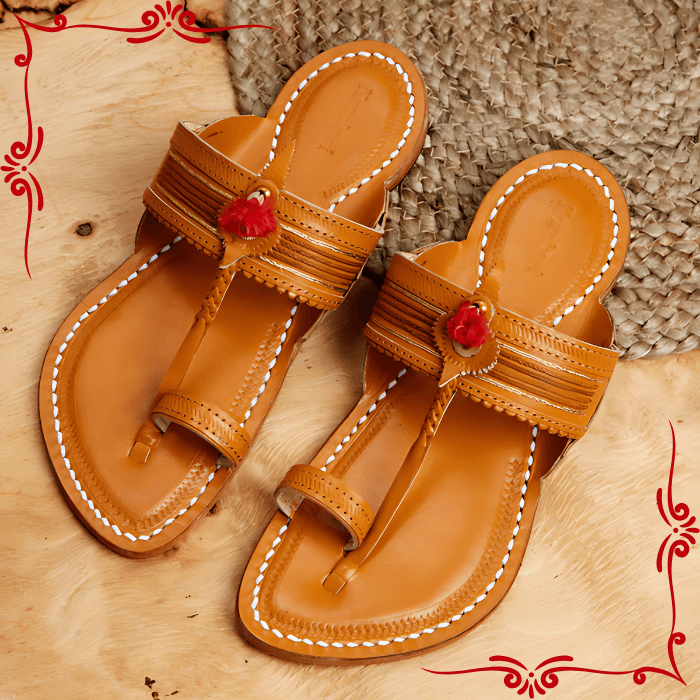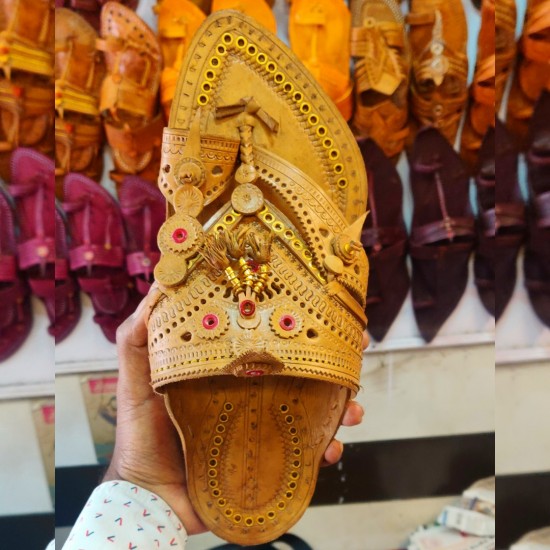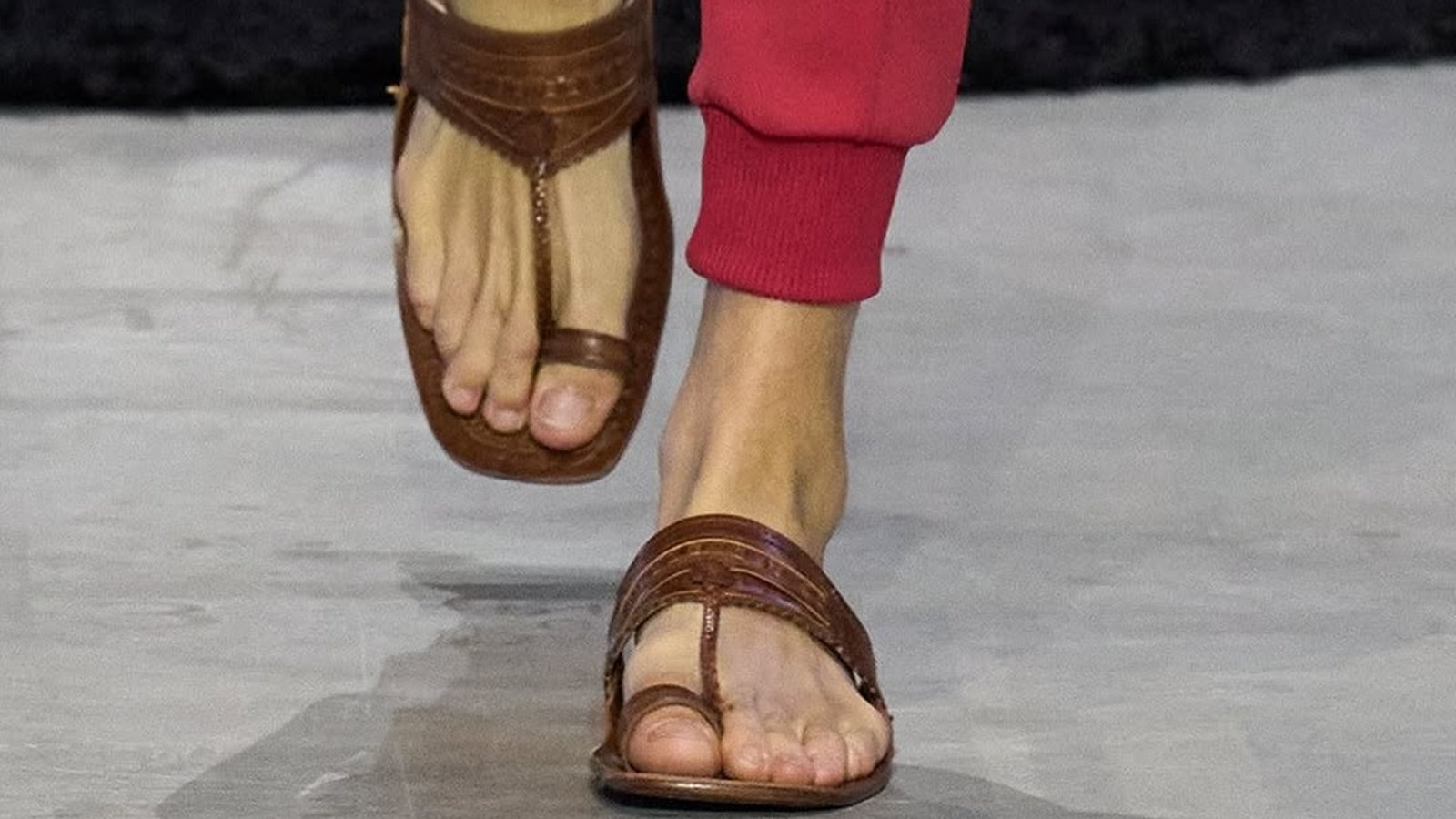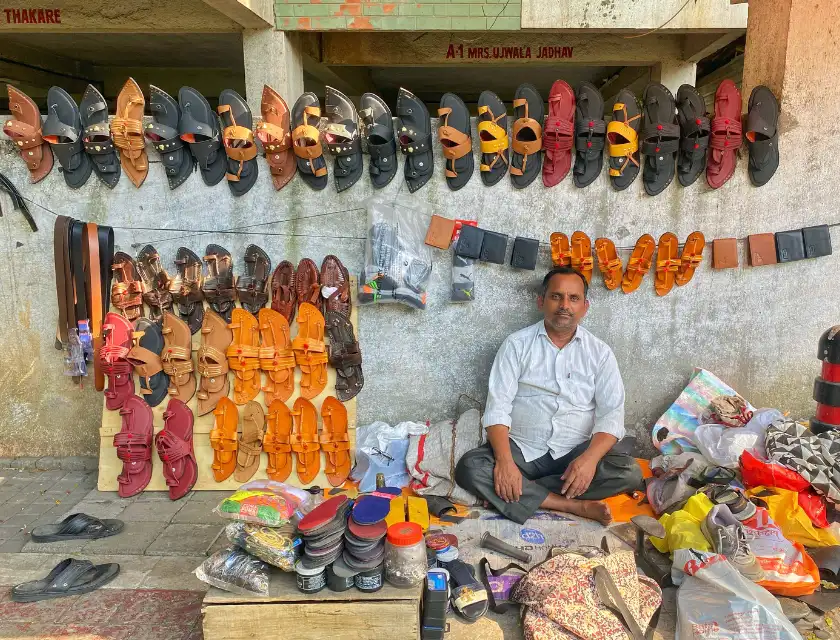Introduction

In June 2025, Italian luxury corporation Prada showcased a familiar braided sandal as a fashion statement—without giving any acknowledgements to Indian artisanal heritage from which it is appropriated from. These culturally expropriated Kolhapuri Chappals have touched global runways and fashion trends. However, this Indian handicraft sandal is deeply embedded in Maharashtrian history and cultural ethos. Steeped with heritage, tan-brown hue, leather, and effervescently thriving to be an epitome of handicraft traditions, Kolhapuri Chappal is more than just a sect of footwear. Since time immemorial, handicraft traditions have been in practice and these Chappals have made their mark as a rigorous craft sustained through centuries of artisanal craftsmanship.

These Chappals have witnessed a trajectory of flourishing crests and devastating troughs. Traditionally, this footwear was crafted by Chamars of Kolhapur and hinterland regions. This has become a hereditary occupation for the inhabitants of Subash Nagar, Kolhapur—wherein a handful of artisans weave together age-old known yet evolved techniques to craft these Kolhapuri Chappals as a vigorous legacy. These pieces of unmatched craftsmanship are durable yet stylish, culturally rooted yet chic. Tracing the tumultuous journey of Kolhapuri Chappals is as wondrous as it is serendipitous.
Historical Roots and Cultural Appropriation

The Kolhapuri Chappals, though reflecting its roots in the name, vary in official terminology from place-to-place from Kapashi, Paytaan, and Kachkadi to Bakkalnali and Pukari. Nonetheless, these regionally composite styles can be traced back to the 13th Century to King Bijjala of Karnataka who sought to aid cobblers. However, they made a poignant mark on society during the reign of Chhatrapati Shahu Maharaj and his son Rajaram in the 18th Century. Eventually, the Saudagar community adopted the handicraft and flourished via its resurgence in the 20th Century. The earlier prototype of this footwear was referred to as Kanwali, which was slicker and appeared to have ears on its side flips. This was commercialised and metamorphosed into present-day Kolhapuris. Initially, this craft was practiced by Scheduled-Castes who would carefully use hides of cows and oxen for obtaining leather.

Cultural appropriation of autochthonous traditions has seen a growing resurgence in contemporary society. Prada recently confessed that its new sandal portrayal on the Milan runway was inspired by Kolhapuri Chappals—after facing critical remarks and major upheaval by netizens and Maharashtra Chamber of Commerce. Lalit Gandhi, the chamber president, had apprised that the collection includes designs that incorporate an intimate resemblance to Kolhapuri sandals. Often getting expropriated by giant glitz conglomerations, these locally rooted artisanal handicraft scarcely ever get their due credit. Kolhapuri chappals also bear a geographical-indication tag since 2019, and the dire need for these acknowledgments and promotion gets to be known when scandalous instances like aforementioned appropriations happen.
Intricacies in Craftsmanship

The designs and motifs of Kolhapuri Chappals have been evolving and changing with respect to temporality and periodical shifts. They have witnessed dynamicity from being ethnically rooted to incorporating modern trends and re-moulding. This footwear is unisex and gender neutral, which is why men, women, and non-binary people can flaunt it alike. Women especially lean toward Kolhapuris because there is a parcel of sandal assortments accessible in the business sector coordinating their sari or dress shading. The most recent examples of Kolhapuris incorporating business acumen and shifting cultural trends are in the marked Khaadis with splendid colours running from violet to electric green, silver and other starking hues. Added to the splendid hues they are additionally embellished by works like gota kinaari, stone work, and careful manual labour. All these most recent redesigns have given the Kolhapuri Chappals an evolved perspective and capability to adapt and reshape.

Kolhapuri chappals are immensely adored as a centuries-old renaissance, and it is preferred by individuals over the globe and subsequently have an incredible interest in the universal business sector. It is cherished and manufactured in the scanty lanes of China, Pakistan, and Europe. The southern region of Maharashtra is well-known for these chappals. These typically open-toed chappals are crafted using buffalo and cattle hide, and their thick construction contributes to their longevity. The primary tools employed include those for basic tasks like slicing, cutting, and stitching the leather. Various sections of animal hide are utilized for creating different components of the chappals. High-quality leather ensures that the chappals have an extended lifespan. Also, enhanced manufacturing techniques result in superior caliber production.
A Retrograde Phenomenon
Kolhapuri chappals carry nearly seven centuries of history on their leather soles, yet the people who make them are struggling to keep this craft alive. According to Dr. Ovhal Vishal Vishnu, there is a paradox, how a product that has become a global heritage brand is today an unsustainable livelihood for the artisans of Kolhapur and beyond. He finds that while Kolhapuris are durable, eco-friendly and popular, they cannot compete with the flood of commercial, mass-produced footwear from brands like Bata, Adidas, and Nike. Artisans earn almost nothing in comparison, barely earning a net profit of 80 rs. per pair, while aforementioned manufacturers make more than double. Their sales are lower too, and their incomes are unstable.
Education plays a big role here: most traditional leather workers are illiterate or only primary-level educated, and caste stigma has meant that the craft remains confined largely to Scheduled Caste communities. Meanwhile, non-leather footwear businesses attract more educated and socially diverse groups, giving them better scope to innovate and expand. Research shows clearly that Kolhapuris are losing ground in the market, not because they lack quality or heritage, but because the system around them has failed to modernize, support, and value the artisans. What emerges most strongly is the irony: a world-famous product is still here, but the very hands that keep the tradition alive are bleak.
Silver Lining: A Way Forward

From Scandinavian scarves to Nehru jackets, from turbans to Kolhapuri Chappals—Indian art and craft has been subject to consistent trailblazing. However, despite the low-hitting sales and trends of historic Kolhapuris, due to its voguish resurgence, the market has seen a whirlpool of embrace towards these Kolhapuri footwear. However, the cost of rising local handicraft traditions in our closets and feet must not be cultural appropriation. The way forward towards a new dawn is in solidarity—coming together to propagate and encourage our niche cultural heritage.
References:
- Shinde, S. B. (2016). PROBLEMS AND PROSPECTS OF LEATHER FOOTWEAR INDUSTRY IN KOLHAPUR CITY [Impact Factor]. Golden Research Thoughts, 4, 1–2. http://oldgrt.lbp.world/UploadedData/8262.pdf
- Reporter, G. S. (2025, June 30). Prada accused of cashing in on Indian culture with Kolhapuri-inspired sandals. The Guardian. https://www.theguardian.com/world/2025/jun/30/prada-accused-of-cashing-in-on-indian-culture-with-kolhapuri-inspired-sandals
- Courier, M., & Courier, M. (2024, September 19). From King Bijjala to GIS: The Evolution of Kolhapuri Chappals | Madras Courier. Madras Courier. https://madrascourier.com/insight/from-king-bijjala-to-gis-the-evolution-of-kolhapuri-chappals
- fliphtml5.com. (2022, September 1). coffee table book Kolhapuri chappal Pages 1-50 – Flip PDF Download | FlipHTML5. https://fliphtml5.com/gvryb/rdkz/basic
- Bokil, Y., Patil, M., & MKSSS’s School of Fashion Technology. (2024). TRANSITIONING KOLHAPURI CHAPPAL: AN EXPLORATION OF VEGAN LEATHER WITH KOLHAPUR ARTISANS. In International Journal of Novel Research and Development (Vol. 9, Issue 3, pp. d222-c222) [Journal-article]. https://www.ijnrd.org/papers/IJNRD2403330.pdf




